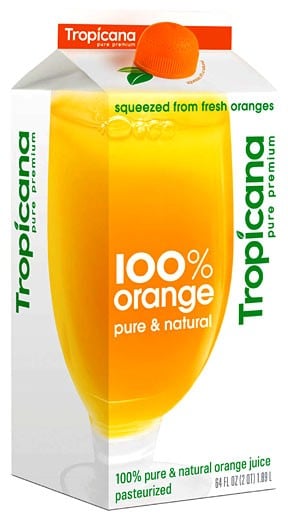Updated on September 30, 2024
Rebranding can be a strong marketing tool. It gives brands a chance to reinvent themselves, pivot to a new direction, and find new ways to stand out from the crowd.
But not all rebrands are successful. History has seen many major companies attempt major rebrands only to fail. Possibly the worst of these was the 2009 Tropicana rebrand.
Tropicana hired ad agency Arnell in 2008 and sank in months (and $35 million) on the rebrand, only to lose $20 million in sales in the first month alone. After just 30 days, they tossed the new packaging and reverted to their original design.
Their mistake is now a case study of one of the worst rebrands in history. Where did they go so wrong? Read on to find out what mistakes they made in their rebrand, and how you can avoid them.
Standing Out…In a Bad Way
Let’s look at the changes Tropicana made, from the original design to the rebranded one:

Original Design (Image via Snap Shop)

Rebranded Design (Image via Snap Shop)
One of the biggest mistakes Arnell made with this redesign is eliminating the thing that really makes orange juice sell—oranges. The new packaging took away the orange, moving it up to the carton lid where it was barely noticeable. Arnell wanted people to feel like they were actually squeezing an orange when they opened the carton. The lid itself was a nice touch, but it failed to stand out on its own.
For the main image, they slapped on a glass of orange juice. Every other successful orange juice brand, from Simply Orange to Minute Maid to Florida’s Natural showcases a big, ripe, perfect orange. It must have been tempting to break the mold. But there’s a reason why an orange is the go-to image.
Sure, when we buy orange juice, we know it isn’t actually freshly squeezed. But that idea—freshness, natural, made from real oranges—that’s what people want. The image of a glass of yellow liquid doesn’t spark that same feeling.
Losing the Big Picture
Tropicana’s original packaging was simple and clear. “Tropicana” was bold, centered, and dark—you couldn’t miss it. On the new packaging, they flipped the words vertically and put them on the right side of the logo, making it hard to find and hard to read.
Worse still, they made the very awkward choice to split the image of the glass of orange juice between the front and the side panels of the carton. In an effort to create something sleek and clever, they failed to do one of the most important things in any food and beverage package design—visualize what the package will look like on the shelf.
When you’re shopping for juice, you don’t see the side of the carton. Splitting the image failed to take into account what it would look like when the only visible portion is the very front. Consumers were left with a half a glass of orange juice and a brand name they couldn’t read.
Making an Unrecognizable Brand
Possibly the worst part of this redesign was that they took away the main thing people associated with Tropicana—the orange and white striped straw.
This one is a real head-scratcher. Tropicana already had something that made them stand out from other brands…something that was easily identifiable—that straw. That’s what people associated with the brand.
Removing the straw took away the iconic Tropicana look, and all of the brand’s personality. Before, Tropicana drinkers could breeze through the aisle, scanning for that straw and grabbing their go-to juice. But after, they had to hunt. It took work to even figure out this was the same juice as before. (And the last thing that anyone wants to do while grocery shopping is work to find what they want.)
Looking for a brand-focused packaging design agency? We can help!
Trying Too Hard
Every change Peter Arnell made was in favor of “modernizing” the brand. He wanted to evolve the brand. But in trying to transform the brand into something modern and edgy, he failed to question whether that’s something the Tropicana consumers even wanted. Tropicana buyers weren’t looking for modern or fancy—they were looking for a fresh brand of juice they knew and loved.
Skipping Out on Market Research
The response to the rebrand was overwhelmingly negative, which came as a complete shock to Arnell and Tropicana. But it shouldn’t have been a shock. Tropicana wasn’t an underperforming, unknown brand, and they weren’t new to the scene. They were completely rehauling an established brand. There should have been a market research campaign done to gauge public response. A few focus groups could have steered them away from the new packaging and helped them avoid the very expensive mistake.
What Lessons Can We Learn?
Nobody wants to sink in money on a rebrand that doesn’t perform well. But sometimes, refreshing your look is necessary. So how do you do it without making the same mistakes Arnell made with the Tropicana rebrand? Stick to these 3 tips:

1. Change with a Purpose
Make sure you have a clear vision of what your goal is before you redesign anything. What aesthetic are you going for? Who is your primary buyer? Who is your dream buyer? If you’re having problems with your existing packaging, spend time figuring out why. When you can approach a rebrand with a clear purpose rather than change for change’s sake, it’s likely to be more successful.
2. Consider Your Audience
Every marketing decision your brand makes needs to center around your target audience. You might think you have the best idea in the world, but if it doesn’t resonate with your audience you will lose money. Get very clear on who your audience is and what they want. Send out surveys, do local market research, and hold focus groups before you uproot an established brand.
3. Don’t Lose Your Brand
If your brand is known for a specific image, logo, or color, don’t ditch that completely. You don’t want your brand to become unrecognizable. Instead, try small tweaks centered around your existing design elements. Tweak your designs slowly instead of completely overhauling what you have.
Follow our tips for a successful rebrand that helps you stand out without losing what makes you special, you’ll want to check out our guide to food packaging design.
Need help from an award-winning food packaging design agency? Let’s talk! We can help.



